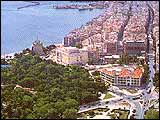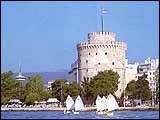|
 Thessaloniki
is one of the oldest cities in Europe, the capital of Macedonia and the second
largest city of Greece after Athens. Greeks often refer to it as the
“co-capital” of Greece due its strategic position, which makes Thessaloniki
one of the most important trade and communications centers as well as a major
cosmopolitan crossroad whose cultural influence is far-reaching. The city’s
landmark is the White Tower, which also houses a Byzantine museum. Worth
visiting is the Archaeological museum that exhibits findings of the archaic,
classical and Roman periods as well as the church of Saint Dimitrios, the holy
patron of the city. Thessaloniki is also known for its exceptional nightlife
with the famous Ladadika quarter. Here you will find bars and clubs playing
great music as well as restaurants and ouzeris among the best in Greece. Thessaloniki
is one of the oldest cities in Europe, the capital of Macedonia and the second
largest city of Greece after Athens. Greeks often refer to it as the
“co-capital” of Greece due its strategic position, which makes Thessaloniki
one of the most important trade and communications centers as well as a major
cosmopolitan crossroad whose cultural influence is far-reaching. The city’s
landmark is the White Tower, which also houses a Byzantine museum. Worth
visiting is the Archaeological museum that exhibits findings of the archaic,
classical and Roman periods as well as the church of Saint Dimitrios, the holy
patron of the city. Thessaloniki is also known for its exceptional nightlife
with the famous Ladadika quarter. Here you will find bars and clubs playing
great music as well as restaurants and ouzeris among the best in Greece.
White Tower 
 This
is a 15th century Venetian circular tower built to form part of the shore
defense system, which was dismantled during the 19th century. The Ottomans used
it as a place for the execution of janissaries, which is why it was known as the
“tower of blood“. Today its named White tower because of its color. The
museum in the White tower contains findings which present the history and art of
Byzantine Thessaloniki covering the period between 300 and 1430 A.D. This
is a 15th century Venetian circular tower built to form part of the shore
defense system, which was dismantled during the 19th century. The Ottomans used
it as a place for the execution of janissaries, which is why it was known as the
“tower of blood“. Today its named White tower because of its color. The
museum in the White tower contains findings which present the history and art of
Byzantine Thessaloniki covering the period between 300 and 1430 A.D.
Archaeological Museum

 The Museum exhibits finds from
all over Northern Greece and in particular: Prehistoric finds from all
over Macedonia and Thrace, and finds belonging to the Geometric Age from
the Vergina burial ground. Archaic and Classical Age sculptures from
ancient Thermi and from other parts of Macedonia. There is also a collection of finds from
excavations on the site of ancient Olynthos. A series of Roman sculptures which is one of the
richest collections of the 1st to the 5th century A.D. A collection
of sarcophagi and glass Roman vases as well as some mosaic floors,
discovered during excavations at Thessaloniki. Noteworthy are the finds from 4th century BC tombs and
Derveni which include bronze and silver vases, weapons gold ornaments, glass
and alabaster The Museum exhibits finds from
all over Northern Greece and in particular: Prehistoric finds from all
over Macedonia and Thrace, and finds belonging to the Geometric Age from
the Vergina burial ground. Archaic and Classical Age sculptures from
ancient Thermi and from other parts of Macedonia. There is also a collection of finds from
excavations on the site of ancient Olynthos. A series of Roman sculptures which is one of the
richest collections of the 1st to the 5th century A.D. A collection
of sarcophagi and glass Roman vases as well as some mosaic floors,
discovered during excavations at Thessaloniki. Noteworthy are the finds from 4th century BC tombs and
Derveni which include bronze and silver vases, weapons gold ornaments, glass
and alabaster
Ladadika

Ladadika was the only quarter to survive the 1917 fire. Once it served as a
storage and trading-place for olive oil. Today is a focal point with numerous
taverns and bars housed in the buildings of past times that have been restored.
How to get there 
By air: from Athen’s Eleutherios Venizelos airport By
car: from Athens By bus: from the KTEL station at Athens By train: from
Piraeus – Athens to Thessaloniki By ferry: from Piraeus and in summer
only, from Volos
|